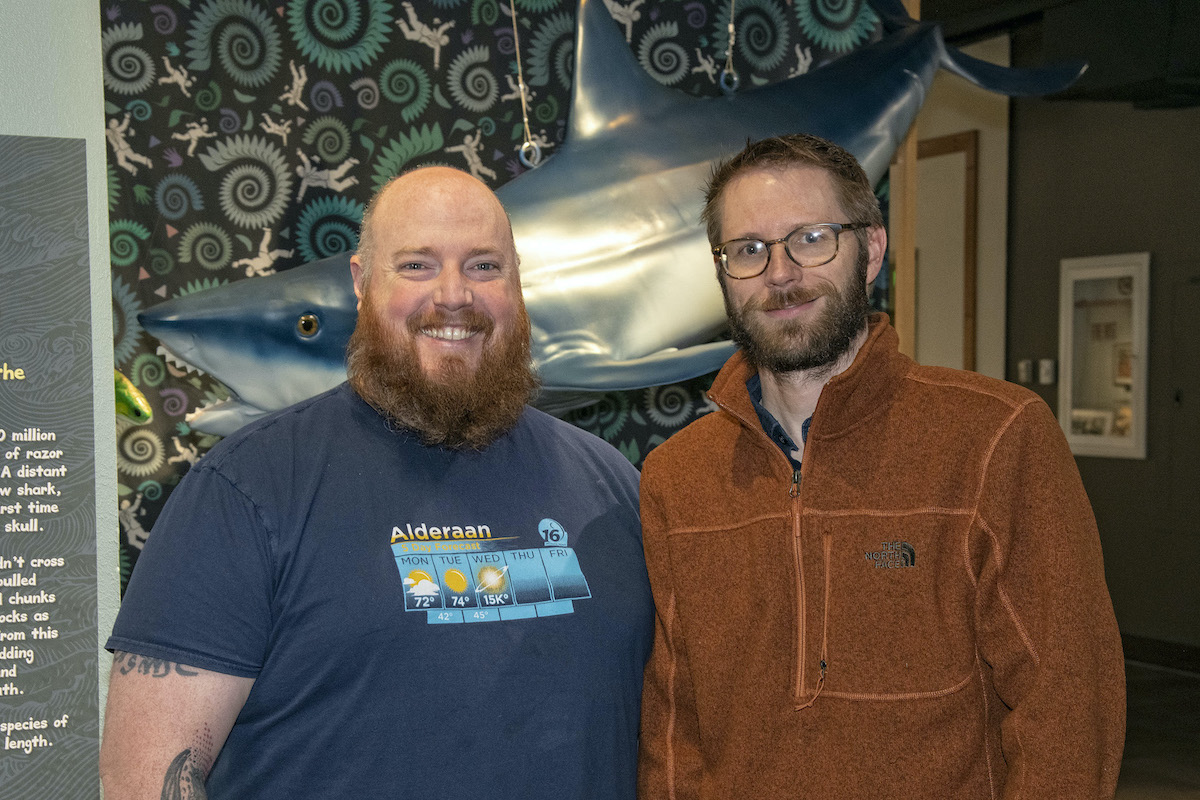Museum, virtual lab team up to learn natural history of ancient scissor-tooth sharks
October 30, 2019

POCATELLO – Oh, what a weird, wonderful and wet world it was in the midwestern United States about 250 million years ago when what is now land was covered by a giant sea.
If you step in a time warp and end up on beach back there somewhere between Chicago and Colorado, don’t be worried about great white sharks because great whites don’t exist, yet. But perhaps a better “Jaws” movie could have been made then, featuring a scissor-tooth shark, that just had a single row of teeth in the midline of its top and bottom jaws that were used like a pair of scissors to capture prey.
“The jaws sliced toward each other like scissors, but there is this backwards, dragging motion, so they could chop and slice,” said Leif Tapanila, an Idaho State University geosciences professor and director of the Idaho Museum of Natural History, where there are models and fossils of the scissor-toothed shark, scientific name Edestus, on display.
Tapanila, working with Jesse Pruitt, the manager of the museum’s Idaho Virtualization Laboratory, are able to travel back in time, to some extent, by analyzing fossil bones and teeth and using 3D-imaging to reconstruct animals that lived in previous geologic time periods.
Tapanila and Pruitt teamed up to produce a study “Redefining species concepts for the Pennsylvanian scissor tooth shark, Edestus” recently published in the journal PLOS ONE that documents previously unknown facts about this shark. The scissor-tooth shark preceded by 10 million years another famous shark in the Idaho Museum of Natural History’s collections and exhibits, the buzzsaw shark, the Helicoprion.
This was the pair’s second paper to be published about the scissor-tooth shark.
“With this paper, we built on the last one,” Tapanila said. “The first paper we had the skull of the animal and we described the skull for the first time, so with this paper we could put the jaw in context to the way the rest of it functioned.”
Previously in scientific literature there were about 14 species of the scissor-tooth shark described from Great Britain to the United States and Russia.
“What this study has done is look at darn near every tooth we could find of this fossil and we asked the question, ‘how many kinds are there?’” Tapanila said. “And because we now have a skull of one of this species, we can make some guesses about how large this animal could get and really try to understand this group because it is part of this bigger group of sharks that are just bizarre, but they dominated the marine world and today they are gone.”
The researchers were able to determine there are only four distinct species of this shark, based on the shape of their teeth and other factors. They were also able to estimate how large they could get, “over 15 feet, in the 16-foot range,” Tapanila said.
“We had all these specimens and were able to measure everything we could and be able to quantify those differences between species,” Tapanila said.
After they were able to narrow the number of this shark species down to four, the scientists were able to learn other new things.
“We can now figure out the expansion of this group,” Tapanila said. “It looks like they first appear in Great Britain (covered in water) and, as the sea level was rising back then, the group expands out into Russia and the United States, so they are the dominate predatory sharks in that time period between Chicago and all the way down to Colorado.”
He said it has taken scientists a long time to figure out some of the mysteries of this species.
“What is really fascinating is that for about 150 years we’ve known these (scissor-toothed shark) teeth exist, but there is so little information about these sharks because they don’t preserve well,” Tapanila said. “It has taken a lot of time to pull together enough information that we can get a fuller glimpse of the diversity of what these animals were like and maybe start asking questions, ‘Why were they so successful?’ ‘Why did they disappear?’”
He said some of the ideas they are developing key on their major prey item, squid, that scissor-toothed sharks were very well equipped to eat. But during this time period, squid and squid relatives were diversifying at this time as well.
“So maybe what was really controlling the predators during that time really has to do with the prey that are becoming more abundant,” he said.
This newly published research demonstrates how ISU geosciences, Idaho Museum of Natural History and the Idaho Virtualization Laboratory are teaming up to do research and create exhibits.
“This is another collaboration with Jesse Pruitt, who is the coauthor on it,” Tapanila said. “The Idaho Virtualization Lab is a big part of what we are able to do. This project started about five years ago and it started with us scanning some of the original fossils over in Philadelphia, at the Academy of Natural Sciences Museum.”
The ISU researchers also studied collections at the Field Museum in Chicago.
“Those collections are just a gold mine, amazing stuff,” Tapanila said.
The same could be said for some of the displays at the Idaho Museum of Natural History where a model of a full-sized of Edestus is on display as part of the museum’s “The Buzzsaw Sharks of Idaho Wicked and Weird exhibit.”
Categories:
